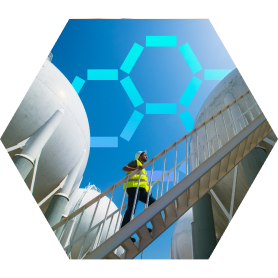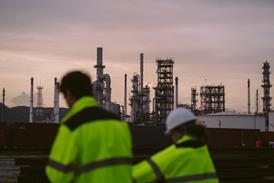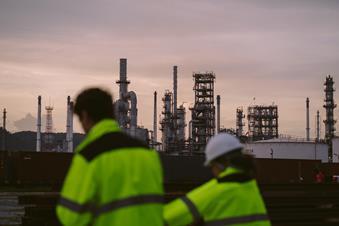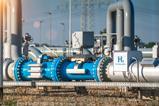Explore this page: CCUS Status | CCUS-enabled hydrogen status | Required policy direction
Carbon capture, usage and storage (CCUS) and hydrogen are vital to the chemical sector’s net zero transition. CCUS can remove emissions from energy-intensive processes, while CCUS-enabled hydrogen provides a low-carbon feedstock and fuel. Together, they can unlock investment in sustainable chemical production, support circular carbon systems, and enhance long-term industrial competitiveness.
Alongside government, businesses are ready to invest to position the UK as a hub for new, low carbon industries, delivering jobs for decades to come. But more can be done to expedite deployment and emission savings, particularly when it comes to CCUS-enabled hydrogen.
CCUS status
CCUS is essential to the green economy with potentially significant growth opportunities for the UK. A strong UK CCUS sector will support well paid, highly-skilled jobs across the UK, with Department of Energy Security and Net Zero (DESNZ) analysis showing CCUS has the potential to generate £4-5 billion GVA per year and support 50,000 jobs in the 2030s across the CCUS industry as the sector matures.
The UK government recognises the pivotal role of CCUS in securing growth, achieving our climate goals and transitioning to a low-carbon economy. To that end, the government has committed to supporting the development and deployment of CCUS technologies in our industrial clusters, through structured programmes and investments.
The UK is home to seven major industrial clusters which produce 50% of all UK industrial emissions. The development of shared CCUS transport and storage infrastructure in these clusters allows for high-impact emissions reductions. In delivering CCUS infrastructure, the cluster sequencing programme also enables the production of CCUS-enabled ‘blue’ hydrogen at scale, which can be used to decarbonise high-heat processes and as a feedstock for low carbon chemicals.
CCUS deployment in the first two clusters is termed ‘Track-1’. The first two ‘Track-1’ clusters were chosen through a DESNZ selection process in 2021, and are HyNet in the North West of England and North Wales, and the East Coast Cluster in Humber and Teesside. Together, HyNet and the East Coast Cluster are targeting the removal of 33 million tonnes of CO2 per year and the creation of 31,000 jobs.
Last year, the government announced £22 billion in funding for the Track-1 CCUS clusters, over 25 years. Shortly after this, the CO2 transport and storage (T&S) network for the East Coast Cluster received a greenlight to progress, and contracts were signed to connect Net Zero Teesside Power to the network. In early 2025, the CO2 T&S network for HyNet also reached financial close, and in September it was announced that two HyNet projects, Heidelberg’s cement plant and Protos’ waste-to-energy plant, had signed contracts to begin construction.
The government has also revealed the next two, ‘Track-2’, clusters in line for CCUS support. These are Acorn, in Scotland, and Viking in the Humber. In the 2025 Spending Review, the government committed £200 million to help Acorn to prepare for delivery, with a Final Investment Decision promised this Parliamentary term. The government expects that both Track-2 clusters could remove up to 18 million tonnes of CO2 from the atmosphere each year.[1]
CCUS-enabled hydrogen status
Yet in both Track-1 clusters, CCUS-enabled hydrogen projects are struggling to move forward amid policy uncertainty. In July, the government announced £500m to support one regional hydrogen network which will permit some CCUS-enabled hydrogen projects to move forward. But funding is only available for one network placing the HyNet and East Coast Clusters in direct competition in a 2026 allocation round, to determine which network will proceed first.
With no certainty on when funding would be forthcoming for a second regional hydrogen network, the announcement presents a significant barrier to investment. The viability of large scale hydrogen projects in both clusters depends on timely access to a hydrogen T&S network, which is now in question. Whichever cluster is chosen, the other will face an uphill battle to maintain investor interest, as planning consents expire and staff and contractors move on.
Adding to the uncertainty around hydrogen T&S networks is the activity of the National Energy System Operator (NESO), which only recently committed to considering the movement of hydrogen between clusters in its Regional Energy Strategic Plans. Securing inter-cluster trading of hydrogen, i.e. through Project Union, would enormously improve the business case for hydrogen projects in all clusters, by increasing liquidity and building economies of scale.
The ‘business models’ which underpin the hydrogen value chain also pose problems. There has been slow progress on their development, with frequent delays to competition timelines leading to investment uncertainty and project delays. Even now, industry still awaits a revised Hydrogen Strategy and CCUS Network Strategy, as well as key updates on the Hydrogen T&S Business Model. These latter will set out DESNZ’s selection process and timeline, as yet unknown.
When it comes to industrial users seeking to access CCUS and hydrogen opportunities, one key area in which clarity is lacking is carbon pricing policy. The UK’s Emissions Trading Scheme (ETS) and Carbon Border Adjustment Mechanism (CBAM) are still under development, and final policy design will have a significant bearing on the business case for investment in our low carbon clusters. Alongside this, is the fact that there is no support for industry to undertake feasibility studies or trials relating to hydrogen/ CCUS connection, ever since the government axed the Industrial Energy Transformation Fund last year.
Required policy direction
Much has been achieved so far. We have a cluster sequencing process. We have long-term commitments of government funding. We have business that want to invest to decarbonise. What we need now is clear policy direction and stability.
Namely:
- An investible Low Carbon Hydrogen Production Business Model
- An investible Hydrogen T&S Business Model
- A clear timeline and selection process for connections to hydrogen and CO2 networks
- Prioritised updates to network codes to support hydrogen T&S
- An accelerated process for decisions on Development Consent Orders
- Capital grants for industrial users to undertake feasibility studies and trials
- A coherent and strategic approach to the movement of hydrogen between clusters
- Final government responses to all outstanding UK ETS consultations
Going forwards, we urge the government to support the development of all clusters based on a readiness assessment rather than its current piecemeal approach (Track-1, Track-2 etc). There are significant cluster decarbonisation opportunities across the UK and all must be prioritised to avoid creating regional winners and losers, and to progress the net zero transition at the pace and scale required.
With Government’s support businesses are ready to invest to position the UK as a hub for new, low carbon industries, delivering jobs for decades to come. Without concerted action now, we risk losing out to competitors, with the result that we are dependent on imports for the chemicals and materials that form the root of our manufacturing supply chain.
[1] Outside of the cluster sequencing process, the government has also recently advanced £29 million to support the Peak Cluster through the National Welath Fund.





















